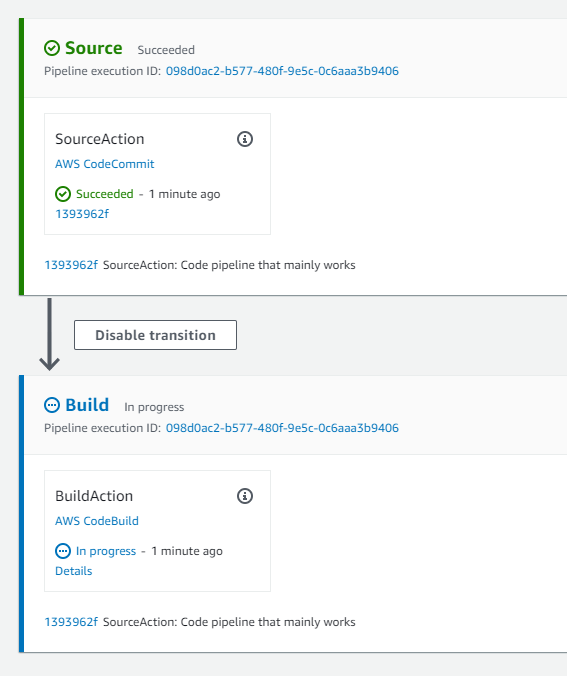Automatically Building and Deploying Jekyll on AWS with CodePipeline
In our last post we covered how to use S3 and CloudFront to host your Jekyll site on AWS statically, which keeps it fast and very inexpensive to operate. In this post, we will cover how to set up CodePipeline and CodeBuild to automatically rebuild the site and publish it to the web whenever you commit a change to your CodeCommit repository. When you’ve hooked up your website in this way, you will never want to go back to the old way: you can just concentrate on adding content and designing your site without having to concern yourself with how it actually gets live on the web. It’s a wonderful way to work.
Building the Jekyll Site Automatically
Whenever we make a change to our Jekyll site – adding a blog post, making
a change to the theme, whatever – we need to rebuild it using the command
jekyll build. To do this on AWS, we use the CodeBuild
service. We’ll only pay for the compute power in the cloud we use as we use it, by
the second, so it’s a very cost effective solution.
Create a new file in your infra directory called codebuild.yml.
If you’ve been following along, you’ll recognize in the CloudFormation
template below some variables that the Serverless Framework will fill in for
us, for example ${self:custom.account} is our account number.
Here’s the file:
# The build project that runs buildspec.yml in the tree
Resources:
CodeBuildServiceRole:
Type: AWS::IAM::Role
Properties:
AssumeRolePolicyDocument:
Version: "2012-10-17"
Statement:
- Effect: Allow
Action:
- sts:AssumeRole
Principal:
Service:
- codebuild.amazonaws.com
CodeBuildServicePolicy:
Type: AWS::IAM::Policy
Properties:
PolicyName: CodeBuildServicePolicy
Roles:
- !Ref CodeBuildServiceRole
PolicyDocument:
Version: "2012-10-17"
Statement:
- Effect: Allow
Action:
- logs:CreateLogGroup
- logs:CreateLogStream
- logs:PutLogEvents
Resource: "arn:aws:logs:${self:provider.region}:${self:custom.account}:*"
- Effect: Allow
Action:
- codecommit:GitPull
Resource: "arn:aws:codecommit:${self:provider.region}:${self:custom.account}:${self:custom.repo}"
- Effect: Allow
Action:
- s3:GetObject
- s3:GetObjectVersion
- s3:PutObject
Resource:
- "arn:aws:s3:::${self:custom.s3Bucket}*"
- Effect: Allow
Action:
- cloudfront:CreateInvalidation
Resource: "*"
CodeBuildProject:
Type: AWS::CodeBuild::Project
Properties:
Name: ${self:custom.project}-${self:custom.stage}
Description: Build for ${self:custom.subdomain}.${self:custom.domain}
ServiceRole: !GetAtt CodeBuildServiceRole.Arn
Artifacts:
Type: CODEPIPELINE
Environment:
Type: linuxContainer
ComputeType: BUILD_GENERAL1_SMALL
Image: aws/codebuild/amazonlinux2-x86_64-standard:3.0
EnvironmentVariables:
- Name: CLOUDFRONT_DISTRO_ID
Value: ${self:custom.cloudfront_id}
- Name: S3_BUCKET
Value: ${self:custom.s3Bucket}
LogsConfig:
CloudWatchLogs:
Status: ENABLED
GroupName: /build/${self:custom.project}-${self:custom.stage}
Source:
Type: CODEPIPELINE
TimeoutInMinutes: 60It’s a pretty long file, it’s true, but there’s nothing complicated here.
The first two stanzas are policies that give the CodeBuild service the privileges it needs to do its work: the ability to write to CloudWatch logs, to pull source code from our git repo that we set up last time, and the ability to copy the created HTML files (the actual website) to the static S3 bucket that houses them.
Then the CodeBuildProject resource is the CodeBuild project itself, which tells
AWS what kind of EC2 instance we need to do the build, and where it should be
getting the source code from (CodePipeline; see below). Note that there are
two environment variables that we’re setting for the instance: S3 bucket
(where the static HTML files that Jekyll builds should go) and the CloudFront
Distribution that’s fronting it.
Triggering the Build on a Code Commit
Now we want to set up our CodePipeline,
which will automatically trigger that build whenever we push any changes to the
master branch of our repo.
Create a file codepipeline.yml in your infra directory with this content:
Resources:
CodePipelineBucket:
Type: AWS::S3::Bucket
Properties:
BucketName: ${self:custom.s3Bucket}-codepipeline
PublicAccessBlockConfiguration:
BlockPublicAcls : true
BlockPublicPolicy : true
IgnorePublicAcls : true
RestrictPublicBuckets : true
CodePipelineServiceRole:
Type: "AWS::IAM::Role"
Properties:
AssumeRolePolicyDocument:
Version: "2012-10-17"
Statement:
- Effect: Allow
Principal:
Service:
- codepipeline.amazonaws.com
Action: "sts:AssumeRole"
Path: /
Policies:
- PolicyName: CodePipelineServicePolicy
PolicyDocument:
Version: "2012-10-17"
Statement:
- Effect: Allow
Action:
- "codecommit:CancelUploadArchive"
- "codecommit:GetBranch"
- "codecommit:GetCommit"
- "codecommit:GetUploadArchiveStatus"
- "codecommit:UploadArchive"
Resource: "arn:aws:codecommit:${self:provider.region}:${self:custom.account}:${self:custom.repo}"
- Effect: Allow
Action:
- "codebuild:BatchGetBuilds"
- "codebuild:StartBuild"
Resource: "*"
- Effect: Allow
Action:
- "s3:*"
Resource: "arn:aws:s3:::${self:custom.s3Bucket}-codepipeline/*"
AmazonCloudWatchEventRole:
Type: "AWS::IAM::Role"
Properties:
AssumeRolePolicyDocument:
Version: "2012-10-17"
Statement:
- Effect: Allow
Principal:
Service:
- events.amazonaws.com
Action: "sts:AssumeRole"
Path: /
Policies:
- PolicyName: CodePipelineExecutionPolicy
PolicyDocument:
Version: "2012-10-17"
Statement:
- Effect: Allow
Action: "codepipeline:StartPipelineExecution"
Resource: "arn:aws:codepipeline:${self:provider.region}:${self:custom.account}:${self:custom.project}-${self:custom.stage}"
AmazonCloudWatchEventRule:
Type: "AWS::Events::Rule"
Properties:
EventPattern:
source:
- aws.codecommit
detail-type:
- CodeCommit Repository State Change
resources:
- "arn:aws:codecommit:${self:provider.region}:${self:custom.account}:${self:custom.repo}"
detail:
event:
- referenceCreated
- referenceUpdated
referenceType:
- branch
referenceName:
- master
Targets:
- Arn: "arn:aws:codepipeline:${self:provider.region}:${self:custom.account}:${self:custom.project}-${self:custom.stage}"
RoleArn: !GetAtt
- AmazonCloudWatchEventRole
- Arn
Id: codepipeline-AppPipeline
AppPipeline:
Type: "AWS::CodePipeline::Pipeline"
Properties:
Name: ${self:custom.project}-${self:custom.stage}
RoleArn: !GetAtt
- CodePipelineServiceRole
- Arn
Stages:
- Name: Source
Actions:
- Name: SourceAction
RunOrder: 1
ActionTypeId:
Category: Source
Owner: AWS
Version: 1
Provider: CodeCommit
Configuration:
BranchName: master
RepositoryName: ${self:custom.repo}
PollForSourceChanges: false
OutputArtifacts:
- Name: SourceArtifact
- Name: Build
Actions:
- Name: BuildAction
RunOrder: 2
ActionTypeId:
Category: Build
Owner: AWS
Version: 1
Provider: CodeBuild
InputArtifacts:
- Name: SourceArtifact
OutputArtifacts:
- Name: BuildArtifact
Configuration:
ProjectName: ${self:custom.project}-${self:custom.stage}
ArtifactStore:
Type: S3
Location: ${self:custom.s3Bucket}-codepipelineThis is another long CloudFormation template, but again there’s nothing conceptually challenging here.
The first stanza just sets up an S3 bucket for the pipeline to place the
source code in, and from which CodeBuild picks it up automatically. We
configure that bucket to be private to us.
Then we set up a policy for the pipeline. It needs the ability to work with CodeCommit, our git repo; to start builds in CodeBuild; and of course to put source code into that S3 bucket we just created.
We also need to give CloudWatch the ability to trigger the builds themselves. Whenever a file is created or updated in the repo, that will kick off the pipeline itself.
Finally we have the AppPipeline pipeline itself. This sets up two distinct
phases: a Source phase, which does a full pull from git and which copies the
output into the code pipeline bucket. This is called the SourceArtifact. That
artifact is referenced as input in the second Build phase.
So, to sum up: whenever there’s a push done to the git repo, the Pipeline will kick in. It will do a full get on the source tree, put a copy of it in S3, and will then trigger the Build.
The BuildSpec File
But how does CodeBuild know how to build a Jekyll website? Well, we need a build specification file that tells CodeBuild what steps exactly it should take.
This is pretty simple: essentially, in the build phase we tell CodeBuild to take the source
code that was given to it by CodePipeline, and run Jekyll on it with the production
configuration settings. That will put the appropriate files in the _site directory
on the EC2 instance doing the build.
Then, in the post_build phase, copy the _site directory over to our S3 bucket for serving. Finally,
invalidate the CloudFront cache so that our reading public can get the latest and the
greatest right away.
If you’ve been following along, your buildspec.yml file should be at the root of your
git repo and should look like this:
version: 0.2
phases:
install:
commands:
- gem install jekyll bundler
- cd website
- bundle install
build:
commands:
- JEKYLL_ENV=production bundle exec jekyll build --config _config.yml,_config_production.yml
post_build:
commands:
- aws s3 sync _site s3://$S3_BUCKET
- aws cloudfront create-invalidation --distribution-id $CLOUDFRONT_DISTRO_ID --paths "/*"Note that the build is getting the S3_BUCKET and the CLOUDFRONT_DISTRO_ID as environment
variables. Those were placed there by CodeBuild, in the EnvironmentVariables section.
Revisiting the Serverless Framework Configuration
As we discussed last time, the serverless.yml file includes the configuration
settings to make all of this work properly. We need to make a few adjusments
so that when we deploy our infrastructure stack, everything is hooked up properly.
Here’s how ours looks now:
service: jekyll-web
custom:
project: jekyll-web
account: '[YOUR ACCOUNT ID]'
certificate: [CERTIFICATE ID]
domain: [YOUR DOMAIN]
sslCertArn: arn:aws:acm:us-east-1:${self:custom.account}:certificate/${self:custom.certificate}
stage: ${opt:stage, self:provider.stage}
subdomain: ${self:provider.environment.${self:custom.stage}_subdomain}
s3Bucket: jekyll-web-${self:custom.stage}
cloudfront_id: ${self:provider.environment.${self:custom.stage}_cloudfront_id}
repo: [YOUR REPO NAME]
provider:
name: aws
stage: prod
region: [YOUR PREFERRED AWS REGION]
environment:
dev_subdomain: dev
dev_cloudfront_id:
prod_subdomain: www
prod_cloudfront_id: [YOUR CLOUDFRONT ID]
stackTags:
Project: Corporate
resources:
- ${file(s3.yml)}
- ${file(cloudfront.yml)}
- ${file(codebuild.yml)}
- ${file(codepipeline.yml)}We’ve added our CodeBuild and CodePipeline infrastructure pieces to the bottom, and we’ve added some custom variables that help us parameterize the scripts so we can use them for other purposes.
Note that the Certificate Arn and the CloudFront ID have to be manually added to the
serverless.yml file for this to work. That’s kind of lame, I admit – but whatever. It works.
Add the Files to Git
OK, we have a number of new files that we’ve added. If you’re doing it exactly the same way we are, your file tree should look like this:
.
├── buildspec.yml
├── infra
│ ├── cloudfront.yml
│ ├── codebuild.yml
│ ├── codepipeline.yml
│ ├── s3.yml
│ └── serverless.yml
├── README.md
└── website
├── 404.html
...
Be sure to add all these files to your git repo.
As soon as you push your commit to the git repo, CodePipeline will recognize that there’s been a change to the tree and will spring into action. If you log into your AWS console and navigate to your new CodePipeline, you should see something like this:
Deploying and Triggering the Build
Deploy all that infrastructure using the Serverless Framework:
$ sls deploy
It will take some time for Serverless to build the CodeBuild and CodePipeline infrastructure elements in AWS.
To test it you can make a trivial change to your Jekyll
site – change the site description in the _config.yml file, for example – and push
it up to git. You should be able to watch CodePipeline start processing.

Conclusion: What Have we Wrought?
We’ve done a lot in this three-step blog series, so it’s worth reviewing.
First, we set up a Jekyll development environment fully in the cloud: we have a Cloud9 environment as our Jekyll IDE, for which we only pay when we are actually using it. The source of our Jekyll site is safely stored in a fully managed git repo in CodeCommit. When we make changes to our Jekyll site and commit those changes to git, a pipeline springs into being and builds static HTML files for the site automatically. These files are then automatically copied over to an S3 bucket, from which our site is securely served behind an SSL certificate. And these HTML files are distributed by CloudFront, a Content Delivery Network, for extremely speedy rendering no matter where in the world your readers are.
Not only does that save a ton of time over the long run, but it does it extremely cheaply and reliably.
We hope this blog series has been useful to you.
